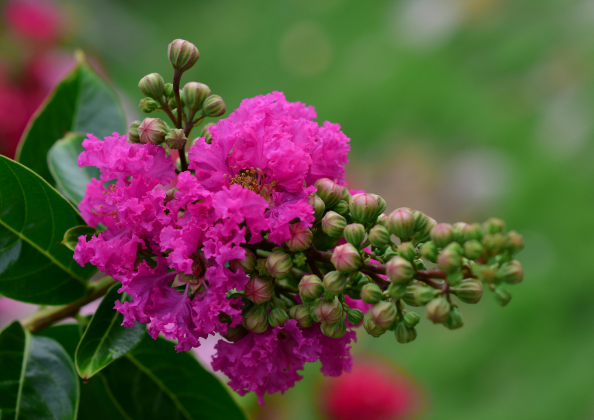Crepe Myrtle Trees: Southern Charm with Year-Round Appeal
Pink Crepe Myrtle Tree Flowers (Lagerstroemia indica)
Crepe myrtle trees (Lagerstroemia indica) are beloved staples in Southern landscapes, known for their vibrant summer blooms, sculptural bark, and fiery fall foliage. Originally native to Asia, these ornamental trees have flourished across USDA Zones 6–9 thanks to their heat tolerance and low-maintenance nature. With varieties ranging from compact shrubs to towering trees over 30 feet tall, crepe myrtles offer versatility for gardens, driveways, and container plantings alike.
Growth Rate & Care
Crepe myrtles thrive in full sun—at least six hours daily is essential for abundant flowering. They’re adaptable to most soil types, provided drainage is good. Slightly acidic soil (pH 5.5–6.5) encourages healthy growth and vivid blooms. While rich soil may lead to excessive foliage at the expense of flowers, a balanced approach with occasional fertilization in spring can support both.
Newly planted crepe myrtles need consistent watering until roots establish—typically the first growing season. Mature trees are drought-tolerant but benefit from deep watering during dry spells, especially before and during bloom periods. Avoid overhead watering to reduce the risk of powdery mildew; instead, water at the base to keep foliage dry and disease-free.
Crepe myrtles bloom on new wood, so late winter or early spring pruning encourages fresh growth and flower production. However, avoid the common mistake known as “crepe murder”—severely cutting back top branches—which can distort the tree’s natural form and weaken future blooms. Instead, remove suckers, crossing branches, and spent flower clusters to maintain shape and promote a second bloom in late summer.
Red Crepe Myrtle Tree
Landscape Design
From the deep red ‘Dynamite’ to the lavender ‘Muskogee’ and compact ‘Berry Dazzle’, crepe myrtles come in a rainbow of colors and sizes. Their exfoliating bark adds winter interest, while fall foliage glows in shades of orange, red, and yellow. Whether used as privacy screens, specimen trees, or container accents, crepe myrtles bring enduring beauty to any landscape. Contact us today for a free estimate to incorporate Crepe Myrtles into your landscaping.

